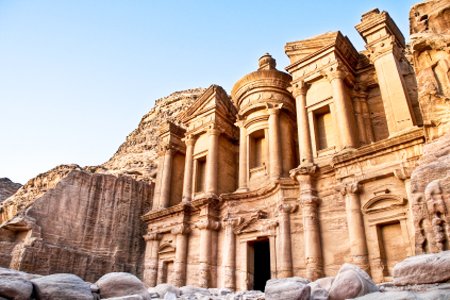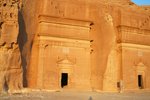UNESCO World Heritage Sites Near Qatar, the UAE, & Saudi Arabia
 For many who choose to live in the Gulf region (Qatar, Saudi Arabia, the United Arab Emirates, etc.), it is not only the country in which one resides which is appealing when one is looking at one's vacation options. Instead, many are attracted by the countries' geographic proximity to other interesting locations. Consider Qatar — situated below the Fertile Crescent, across the desert from Egypt, and separated by the Gulf from Persia, Qatar is truly only a stone's throw away from the wonders of the ancient world. The same can be said for its neighboring countries, such as Saudi Arabia and the United Arab Emirates. Having travelled extensively throughout the ancient world, I can truly attest to the pull of these timeless sites. Whether it be a crumbling, ivy-covered Roman amphitheater or an abandoned city, forgotten in the swirling sands of time, the sights of the ancient world never fail to awe those who come into contact with them. The following is a list of just some of the nearby UNESCO World Heritage Sites, which should not be missed if you are going to be living in the Gulf Region: SAUDI ARABIASaudi Arabia has eight locations on the list, seven cultural, and one natural: Al-Ahsa Oasis, Saudi ArabiaLocated in eastern Saudi Arabia Al-Ahsa Oasis is the largest in the world. It boasts 2.5 million date palms and traces of human habitation from the Neolithic Age. Al-Hijr (Hegra Archaeological Site), Saudi ArabiaFound in northwestern Saudi Arabia, Al-Hijr, more commonly known as Medain Saleh ("Cities of Saleh"), is one of the largest remaining sites from the Nabataean civilization. The site is home to over a hundred beautifully decorated tombs and is best seen at sunset. Also see Petra, above. At-Turaif District in Riyadh, Saudi ArabiaAs described on the UNESCO page, this district, in Dariyah, outside Riyadh, "... was the first capital of the Saudi Dynasty, in the heart of the Arabian Penisula, north-west of Riyadh. Founded in the 15th century, it bears witness to the Najdi architectural style, which is specific to the centre of the Arabian peninsula. In the 18th and early 19th century, its political and religious role increased, and the citadel at at-Turaif became the centre of the temporal power of the House of Saud and the spread of the Wahhabi reform inside the Muslim religion. The property includes the remains of many palaces and an urban ensemble built on the edge of the ad-Dir’iyah oasis." Hima Cultural AreaSet in the mountains of southwestern part of the Kingdom, the Hima Cultural Area, the area boasts a large collection of rock art images depicting hunting, fauna, flora and lifestyles spanning 7,000 years. Rock Art in the Hail Region of Saudi ArabiaThis site, according to UNESCO, "... includes two components situated in a desert landscape: Jabel Umm Sinman at Jubbah and the Jabal al-Manjor and Raat at Shuwaymis. A lake once situated at the foot of the Umm Sinman hill range that has now disappeared used to be a source of fresh water for people and animals in the southern part of the Great Narfoud Desert. The ancestors of today’s Arab populations have left traces of their passages in numerous petroglyphs and inscriptions on the rock face. Jabal al-Manjor and Raat form the rocky escarpment of a wadi now covered in sand. They show numerous representations of human and animal figures covering 10,000 years of history." Historic Jeddah, the Gate to Makkah, Saudi ArabiaAs stated on the UNESCO page, Historic Jeddah "... is situated on the eastern shore of the Red Sea. From the 7th century AD it was established as a major port for Indian Ocean trade routes, channelling goods to Mecca. It was also the gateway for Muslim pilgrims to Mecca who arrived by sea. These twin roles saw the city develop into a thriving multicultural centre, characterized by a distinctive architectural tradition, including tower houses built in the late 19th century by the city’s mercantile elites, and combining Red Sea coastal coral building traditions with influences and crafts from along the trade routes." The Cultural Landscape of the Al-Faw Archeological AreaLocated in southwestern Saudi Arabia, the Al-Faw Archeological Area is located "at a strategic point of the ancient trade routes of the Arabian Peninsula, [and] the property was abruptly abandoned around the 5th century CE." Archeological remains date from the Neolithic to the late pre-Islamic era. 'Uruq Bani Ma'aridThe 'Uruq Bani Ma'arid is on the edge of the Rub' al Khali, or "The Empty Quarter." As described by UNESCO, "The property encompasses the western part of the greatest expanse of windblown sand on Earth, known as Ar Rub' al-KhaIi, and conserves a portion of one of the Earth’s most spectacular desert landscapes. " JORDANPetra, JordanDescribed by Swiss explorer Johann Ludwig Burckhardt in 1812 as the "rose-red city half as old as time," Petra has long been a fascination to Westerners. The ancient Nabataean city is famous for being elaborately carved, right out of the surrounding mountains, accessible only by a long, narrow stone passageway. The site is located in Jordan, it's about a two-hour flight from the capital of Jordan, Amman, to Doha, Qatar, or Riyadh, Saudi Arabia. (Movie buffs may also be familiar with Petra, from the third Indiana Jones film.) Also see Al-Hijr, below. Baptism Site “Bethany Beyond the Jordan” (Al-Maghtas), JordanThis dual site is described by UNESCO as, "Situated on the eastern bank of the River Jordan, nine kilometres north of the Dead Sea, the archaeological site consists of two distinct areas: Tell Al-Kharrar, also known as Jabal Mar-Elias (Elijah’s Hill) and the area of the churches of Saint John the Baptist near the river. Situated in a pristine natural environment the site is believed to be the location where Jesus of Nazareth was baptized by John the Baptist. It features Roman and Byzantine remains including churches and chapels, a monastery, caves that have been used by hermits and pools in which baptisms were celebrated, testifying to the religious character of the place. The site is a Christian place of pilgrimage." SYRIACrac des Chevaliers and Qal’at at Salah El-Din, SyriaThese two old Crusader castles saw intense action during the Crusades and changed hands many times. Today, the castles are a pleasure to visit. Syria's capital, Damascus, is about a 2.5 to three-hour flight from Doha or about 2.5 hours from Riyadh, Saudi Arabia. Palmyra, SyriaPalmyra was an important stop along the ancient caravan route. The ruins of the city contain remarkably well-preserved funerary busts of its inhabitants. Syria's capital, Damascus, is about a 2.5 to three-hour flight from Doha or about 2.5 hours from Riyadh, Saudi Arabia. Since its destruction by IS in 2015, efforts are being made to restore some of the damage. TURKEYEphesus, TurkeyA spectacular site, once home to a Wonder of the World, Ephesus is described by UNESCO as, "Ephesus comprises successive Hellenistic and Roman settlements founded on new locations, which followed the coastline as it retreated westward. Excavations have revealed grand monuments of the Roman Imperial period including the Library of Celsus and the Great Theatre. Little remains of the famous Temple of Artemis, one of the “Seven Wonders of the World,” which drew pilgrims from all around the Mediterranean. Since the 5th century, the House of the Virgin Mary, a domed cruciform chapel seven kilometres from Ephesus, became a major place of Christian pilgrimage. The Ancient City of Ephesus is an outstanding example of a Roman port city, with sea channel and harbour basin." Istanbul, TurkeyIstanbul is probably one of the most interesting cities in the world. Located on the banks of the Bosphorus, the city had major influence in shaping the world we know today and has played witness to the rise and fall of almost every major empire in history. Flights from Doha, Qatar, or Riyadh, Saudi Arabia to Istanbul take about three hours. EGYPTThe Pyramids at Gaza, EgyptA symbol of Ancient Egypt, the Pyramids at Giza continue to stimulate the imaginations of romantics, skeptics and adventurers. Located just outside the Egyptian capital at Cairo, the pyramids are mandatory for anyone visiting the Middle East. Flights from Doha to Cairo take about 3.5 hours, and from Riyadh, Saudi Arabia to Cairo take about three hours. Thebes, EgyptThebes was an influential and city of Ancient Egypt. The ruins of the city attest to the architectural greatness of its inhabitants. This ancient city is located in Southern Egypt. Flights from Doha to Cairo take about 3.5 hours, and from Riyadh, Saudi Arabia to Cairo take about three hours. LEBANONBaalbek, LebanonLocated in Lebanon, Baalbek is home to some of the best-preserved Roman architecture in the world. Visiting this site gives you the impression of stepping back in time. Flights from Doha to Beirut, take about 3.25 hours, and flights from Riyadh, Saudi Arabia to Beirut take about 2.5 hours. Ouadi Qadisha (the Holy Valley) and the Cedar Forests of God, LebanonOuadi Qadisha served as a refuge for early Christians who were forced to flee into the hills. The surrounding cedar forests are composed of the oldest trees in the world. Flights from Doha to Beirut, take about 3.25 hours, and flights from Riyadh, Saudi Arabia to Beirut take about 2.5 hours. IRANPersepolis, IranLocated in southwestern Iran, to the east across the Persian Gulf from Qatar, Saudi Arabia, and the United Arab Emirates, the ancient City of Persepolis was once the ceremonial capital city of the ancient Persian Empire (550-330BCE). At its height, Persepolis controlled lands spanning three continents, which contained 20% of the world's population. Enjoy your holiday planning! Most Popular |
Related |
Copyright (C) 2025 Helen Ziegler and Associates. All rights reserved.




